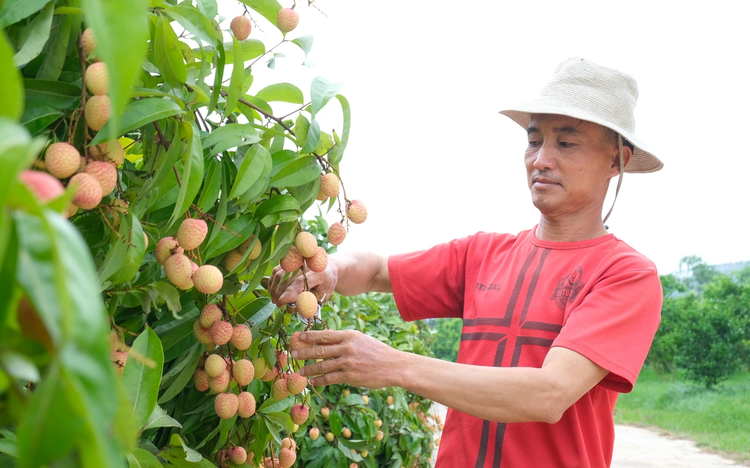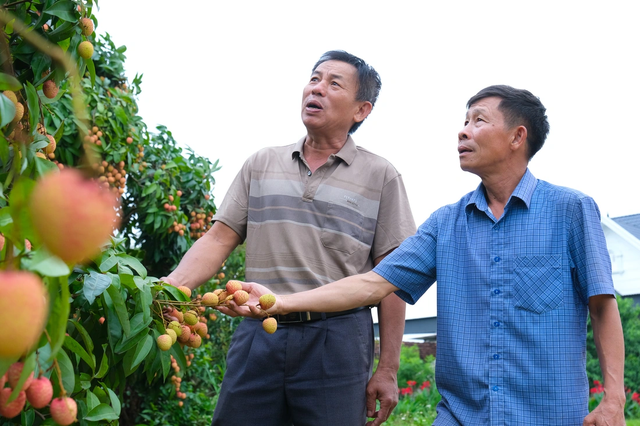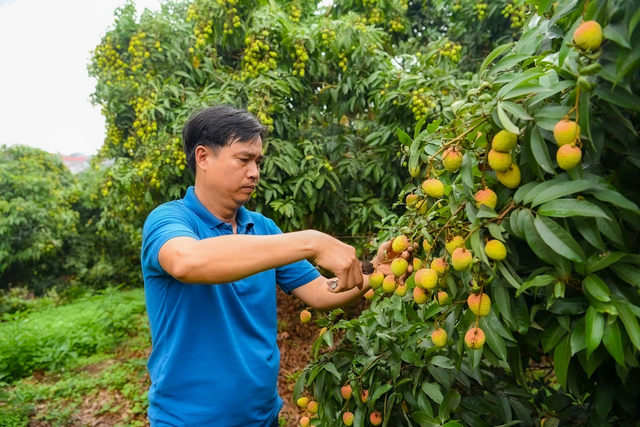
Taking advantage of the cooler weather after a long day of nearly 40°C heat, Duong Van Chien, a farmer in Bac Giang Province, northern Vietnam, prunes his lychee trees in preparation for traders coming to buy. Photo: Ha Quan / Tuoi Tre
Despite erratic weather over the past few days, farmers in lychee-growing hubs in Bac Giang have consistently tended to their orchards and pruned trees to ensure the highest quality for export.
“U hong lychees ripen earlier than the main-season lychees [in mid-June], so they are favored by Chinese businesses," shared Duong Van Chien, a local farmer.

During peak harvest, an orchard needs five to seven laborers, each paid VND300,000-400,000 ($11.5-15.4) per day. The freshest lychees are picked at night and must be loaded onto export trucks by 9:00 am the next day at the latest, said Nguyen Van Hong, a representative of the Tan Moc agricultural product consumption service cooperative in Bac Giang Province, northern Vietnam. Photo: Ha Quan / Tuoi Tre
With around 200 metric tons of high-quality lychees set for export and distribution to southern localities such as Ho Chi Minh City, Nguyen Thi Tra, a representative of the Binh Nguyen clean agricultural cooperative in Bac Giang, expressed her hope that authorities would continue supporting agricultural trade connections, reduce transport time, and explore ways to extend the lychee season.
Over the past two to three years, Chinese buyers have increased quality standards, such as requiring leaves to be removed or lychees to be bundled by weight.
Farmers hope for more training and technical support, according to Tra.
In Phuc Hoa Commune, Tan Yen District—a hub for early-season lychees—the fruit is also about to reach peak ripeness.
In 2025, with around 1,250 hectares under cultivation, the area’s total yield is expected to reach 15,000 metric tons.
Of this, early-season lychees are projected to contribute 9,000 metric tons, up 500 metric tons compared to 2024.

Early-season lychees are nearing peak harvest. Photo: Thanh Cong / Tuoi Tre
Ngo Van Cuong, a farmer in Phuc Hoa Commune, noted that as of Monday, traders had begun to visit orchards, and the number of traders is expected to increase in four to five coming days as the main season starts.
With around 1.2 hectares, he expects a yield of 10–15 metric tons and a price above VND35,000 ($1.3) per kilogram.
As he has signed agreements with export companies, he must follow proper processing and packaging standards for markets like the U.S., Japan, the EU, and Thailand.
Amy Nguyen, chairwoman of Dragonberry Produce—an enterprise working with lychee farmers in Phuc Hoa—shared that since 2022, the company has adjusted its production and post-harvest processes to meet export standards for fresh lychees to the U.S., Canada, and Japan.
These include Global GAP standards and export codes granted by the U.S. Department of Agriculture’s Animal and Plant Health Inspection Service.
Despite strong demand in high-end markets, she noted that the export process remains complex, requiring strict compliance with food safety, labeling, and irradiation treatment regulations.
“One major bottleneck is Vietnam’s limited irradiation processing capacity. Delays in this step can affect the fruit’s freshness and increase logistics costs,” she said, urging authorities to develop suitable solutions.
In the long term, the company proposes that authorities support the development of new lychee varieties suitable for long-distance shipping, apply technologies to extend shelf life, and invest in comprehensive logistics systems.

The early-season lychee-growing area in Phuc Hoa Commune, Tan Yen District, Bac Giang Province, northern Vietnam after a light rain. Photo: Thanh Cong / Tuoi Tre
La Van Nam, deputy director of the Bac Giang Department of Industry and Trade, said lychee is a long-established specialty and key crop of the province, with an estimated annual production value of VND5 trillion ($192 million).
Bac Giang has taken early initiatives to promote lychee exports to markets such as China, Japan, South Korea, the U.S., and Europe, as well as to major domestic tourist destinations like Nha Trang, Da Nang, and Phu Quoc, and key southern markets including Ho Chi Minh City and the Mekong Delta.
To support farmers and businesses, the province has signed contracts with distributors, retail channels, e-commerce platforms, and express delivery services to ensure that fresh lychees reach consumers as quickly as possible.
In 2025, Bac Giang’s total lychee output is expected to reach 165,000 metric tons, including 60,000 metric tons of early-season lychees and 105,000 metric tons of main-season lychees.


Max: 1500 characters
There are no comments yet. Be the first to comment.